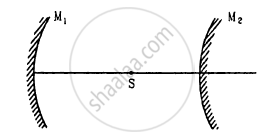Advertisements
Advertisements
प्रश्न
A converging mirror M1, a point source S and a diverging mirror M2 are arranged as shown in figure. The source is placed at a distance of 30 cm from M1. The focal length of each of the mirrors is 20 cm. Consider only the images formed by a maximum of two reflections. It is found that one image is formed on the source itself. (a) Find the distance between the two mirrors. (b) Find the location of the image formed by the single reflection from M2.

उत्तर
Given,
Converging mirror M1 with focal length (f1) = 20 cm
Converging mirror M2 with focal length (f2) = 20 cm
f1 = f2 = 20 cm = f
Point source is at a distance of 30 cm from M1.
As the 1st reflection is through the mirror M1,
u = −30 cm
f = −20 cm
Using mirror equation:
\[\Rightarrow \frac{1}{v} + \frac{1}{u} = \frac{1}{f}\]
\[\Rightarrow \frac{1}{v} + \frac{1}{- 30} = - \frac{1}{20}\]
\[\Rightarrow \frac{1}{v} = - \frac{1}{20} + \frac{1}{30}\]
\[ \Rightarrow \frac{1}{v} = - \frac{1}{60}\]
\[ \Rightarrow v = - 60 \text{ cm }\]
and for the 2nd reflection at mirror M2,
u = 60 − (30 + x) = 30 − x
v = − x, f = 20 cm
Again using the mirror equation:
\[\Rightarrow \frac{1}{30 - x} - \frac{1}{x} = \frac{1}{20}\]
\[\Rightarrow \frac{x - 30 + x}{x(30 - x)} = \frac{1}{20}\]
⇒ 40x − 600 = 30x − x2
⇒ x2 + 10x − 600 = 0
\[\Rightarrow x = \frac{10 + 50}{2} = \frac{40}{2}\]
= 20 cm or − 30 cm
∴ Total distance between the two lines is 20 + 30 = 50 cm
(b) Location of the image formed by the single reflection from M2 = 60 \[-\] 50 = 10
Thus, the image formed by the single reflection from M2 is at a distance of 10 cm from mirror M2.
APPEARS IN
संबंधित प्रश्न
Why can’t we see clearly through fog?
Why does unpolarised light from a source show a variation in intensity when viewed through a polaroid which is rotated?
Draw the intensity distribution for the diffraction bands produced due to single slit ?
Describe briefly using a diagram how sunlight is polarised ?
Suppose you are inside the water in a swimming pool near an edge. A friends is standing on the edge. Do you find your friend taller or shorter than his usual height?
The image formed by a concave mirror
A concave mirror having a radius of curvature 40 cm is placed in front of an illuminated point source at a distance of 30 cm from it. Find the location of the image.
A concave mirror forms an image of 20 cm high object on a screen placed 5.0 m away from the mirror. The height of the image is 50 cm. Find the focal length of the mirror and the distance between the mirror and the object.
Light is incident from glass (μ = 1.50) to water (μ = 1.33). Find the range of the angle of deviation for which there are two angles of incidence.
A container contains water up to a height of 20 cm and there is a point source at the centre of the bottom of the container. A rubber ring of radius r floats centrally on the water. The ceiling of the room is 2.0 m above the water surface. (a) Find the radius of the shadow of the ring formed on the ceiling if r = 15 cm. (b) Find the maximum value of r for which the shadow of the ring is formed on the ceiling. Refractive index of water = 4/3.
A biconvex thick lens is constructed with glass (μ = 1.50). Each of the surfaces has a radius of 10 cm and the thickness at the middle is 5 cm. Locate the image of an object placed far away from the lens.
Explain: ‘How is a rainbow formed’?
Answer the following question in detail.
Explain the formation of a primary rainbow. For which angular range with the horizontal is it visible?
Explain the formation of primary and secondary rainbow.
A parallel beam of light of wavelength 5890 Å falls normally on a slit of width 0.2 mm. Find the distance between the first minima on the two sides of the central maximum of the diffraction pattern observed on a screen placed in the focal plane of a convex lens of focal length 50 cm. The lens is placed quite close to the slit.
| Case study: Mirage in deserts |
 |
|
To a distant observer, the light appears to be coming from somewhere below the ground. The observer naturally assumes that light is being reflected from the ground, say, by a pool of water near the tall object. Such inverted images of distant tall objects cause an optical illusion to the observer. This phenomenon is called mirage. This type of mirage is especially common in hot deserts. Based on the above facts, answer the following question: |
A diamond is immersed in such a liquid which has its refractive index with respect to air as greater than the refractive index of water with respect to air. Then the critical angle of diamond-liquid interface as compared to critical angle of diamond-water interface will
Between the primary and secondary rainbows, there is a dark band known as Alexandar’s dark band. This is because ______.
- light scattered into this region interfere destructively.
- there is no light scattered into this region.
- light is absorbed in this region.
- angle made at the eye by the scattered rays with respect to the incident light of the sun lies between approximately 42° and 50°.
